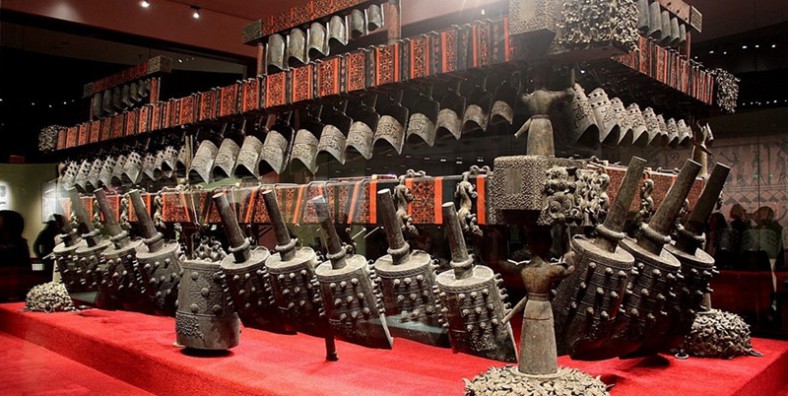
Hubei Provincial Museum

Attractions Overview
Hubei Provincial Museum is a national first-class museum and a national AAAAA tourist attraction. It is also a national comprehensive museum with the largest scale, richest collection and strongest scientific research strength in Hubei Province.
Chinese Name: 湖北省博物馆
English Name: Hubei Provincial Museum
Type: Wuhan Scenic Area, Wuhan famous spots & Artificial attractions
Best Time: All Year Around
Recommended Visiting Hours: 2-3 hours
Opening Hours: Tuesday to Sunday 9: 00-17: 00, closed on Monday (except legal holidays)
Location: Wuchang District, Wuhan City, Hubei Province
Why is Hubei Provincial Museum So Special?
It collects, protects and displays cultural relics found in the province. Since 1953, it has collected more than 200,000 cultural relics, including pottery, porcelain, jade, bronze, ancient weapons and ancient musical instruments. Of these, 812 are listed as China’s first-class cultural relics and 16 are regarded as national treasures.
Where is Hubei Provincial Museum
Hubei Provincial Museum is located on the bank of East Lake Scenic Area in Wuhan, capital of Hubei Province, China. It is a symbol of Wuhan City. Hubei Provincial Museum is the largest national comprehensive museum in Hubei Province, with the richest collection and the strongest scientific research strength.
History of Hubei Provincial Museum
The museum moved to its present location in 1960 and acquired its present name in 1963. Since 1999, some new buildings have been added.
In January 1999, the chime hall with a construction area of 5717 square meters was completed and opened.
In December 2005, Chu Culture Center was completed and opened.
In 2009, it was appraised as a national museum jointly built by China and the mainland by the State Administration of Cultural Heritage.
Main Attractions of Hubei Provincial Museum
Hubei Provincial Museum is divided into three parts: the Chime Bells Exhibition Hall, the Chu (a state in the Spring and Autumn Period (770 – 476BC)) Culture Exhibition Hall, and the Comprehensive Exhibition Building. The Comprehensive Exhibition is still under construction at the present time.
Chime Bells Exhibition Hall
The Chime Bells Exhibition Hall in Hubei Provincial Museum contains two parts: the Exhibition Hall and the Music Hall.
Exhibition hall
In the exhibition hall, you can see many cultural relics unearthed from the tombs of the warring States period Zeng Guo (476-221 BC), such as exquisite bronze vessels “stand out antlers”, ancient halberds, triangular swords “Shu”, and ancient bamboo slips used for writing. The most famous treasure is the chime, which is the largest bronze musical instrument ever discovered. With a set of bells of different sizes, it can play the tones of different scales with quite beautiful timbre. There are about 3000 ancient Chinese characters on the clock, describing the music and the owner of this musical instrument.
Music hall
In the Music hall, musicians dressed in ancient costumes play copies of bells every day. You will definitely be fascinated by ancient and beautiful music, which has been played many times overseas.
Chime Bells Performance (25mins):
| Ticket Fare | CNY30; free for children under 1.4m (4.6ft). |
|---|---|
| Schedule | Mar. – Nov.: Tue. – Fri.: 10:30, 14:00, 15:00 Weekends: 10:30, 11:30, 14:00, 15:00 |
| Dec. – Feb.: Tue. – Fri.: 11:00, 15:00 Weekends: 11:00, 14:00, 15:00 |
|
| On holidays: 10:00, 11:00, 12:30, 14:00, 15:00 |
Chu Culture Exhibition Hall
The Chu Culture Exhibition Hall of Hubei Provincial Museum shows Chu’s regional culture. Most of the cultural relics displayed here are bronze ware, lacquer ware, bamboo and wood products and silk knitwear. You can also see various ancient weapons of Chu, such as the swords of Gou Jian (King of Yue in the Spring and Autumn Period) and Fu Cha (King of Wu in the Spring and Autumn Period). In 2002, archaeologists discovered Chu’s chariots and horses. After careful repair, some chariots and horses are now displayed in this hall. In addition to the unearthed cultural relics, they also showed tourists some restoration models of houses inhabited by the Chu people, giving them a more direct impression of the life of the ancient Chu people.
Hubei Provincial Museum also has antique shops. After visiting the two exhibition halls, you can buy some souvenirs if you like.
Best Time to Travel Hubei Provincial Museum
The best time to pay a visit is in all year around.
Wuhan has a monsoon (humid) climate in the northern subtropics, which is characterized by abundant rainfall, sufficient heat, the same season of rain and heat, the same season of light and heat, the same season of winter and Leng Xia heat, and distinct seasons.
How to Get There
- Take Bus Route 402, 411, 552, 701 to Hubei Province Museum Station, then walk there;
- Take Subway Line 4 to Dongting (东亭), then walk for 20 minutes to get there;
Useful Travel Tips
| Entrance Fee | Free |
|---|---|
| Opening Hours | 9:00 – 17:00 (entering stops at 16:00); Closed on Monday (except on holidays) and the day of New Year’s Eve. |














